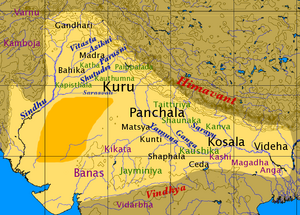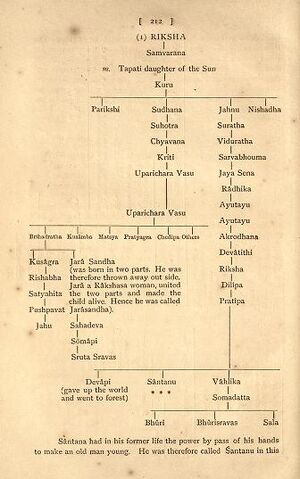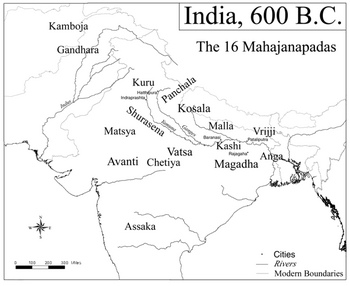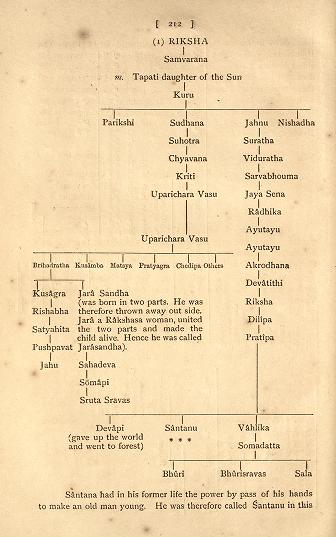Kuru
| Author:Laxman Burdak, IFS (R) |

Kuru (कुरु) was the name of a Vedic Indo-Aryan tribal union in northern Iron Age India, encompassing the modern-day states of Delhi, Haryana, Punjab and the western part of Uttar Pradesh (the region of Doab, till Prayag), which appeared in the Middle Vedic period[1][2] (c. 1200 – c. 900 BCE) and developed into the first recorded state-level society in the Indian subcontinent.[3]
Variants
- Kuru (कुरु) (AS, p.206)
- Kuru Janapada (कुरु-जनपद)(AS, p.206)
- Turghna तूर्घ्न दे. Kuru कुरु (AS, p.409)
- Parinaha परिणाह, दे. कुरु, (AS, p.532)
Location
In the epic times (final centuries BC), the region between the triangle of Thaneshwar, Hissar and Hastinapur was distinguished by three different names:
- (1) Kuru-Jangala equal to Rohtak, Hansi, Hissar
- (2) Kuru-rashtra proper between the Ganga and Yamuna with its capital at Hastinapura and
- (3)Kuru-kshetra comprising Thaneshwar, Kaithal and Karnal.
Genealogy of Vahlika

Genealogy of Bahlika as per Bhagavata Purana[4] Riksha → Samvarana (m. Tapati) → Kuru → Jahnu → Suratha → Viduratha → Saryabhauma → Jaya Sena → Radhika → Ayutayu → Akrodhana → Devatithi → Riksha → Dilipa → Pratipa → Vahlika → Somadatta → Bhuri + Bhurisravas + Sala
Genealogy
Ram Swarup Joon[5] provides genealogy of Second Branch of Yayati (Puru) dynasty in branch of Hasti (Founder of Hastinapur):
Hasti (Founder of Hastinapur) → Yana → Akshaya → Vilaksha → → Sambha → Vishwamitra → Devrat → Inka → Aksan → Samoran → Kuru → Barak-Shatger → Jhanu → Sorata → Sorabhum → Jatuson → Wadika → Anyo-Vayo → Dalip → Shantanu (From wife Satyavati) → Vichitra Virya
Jat Clans
Kuru (कुरु)/ Kuruvanshi (कुरुवंशी)[6] is a gotra of Jats. [7] They were rulers in Central Asia. [8]
Mention by Panini
Kuru (कुरु) is mentioned by Panini in Ashtadhyayi. [9]
Kurū (कुरू) is mentioned by Panini in Ashtadhyayi. [10]
Kuru-garhapatan (कुरुगार्हपतन) is mentioned by Panini in Ashtadhyayi. [11]
Kuru Gotra (कुरु गोत्र) is mentioned by Panini in Ashtadhyayi. [12]
Kuru : Indo-Aryan tribe

Kuru (कुरु) was the name of an Indo-Aryan tribe and their kingdom in the Vedic civilization of India, and later a republican Mahajanapada state. Their kingdom was located in the area of modern Haryana (Kurukshetra). They formed the first political center of the Indo-Aryans after the Rigvedic period, and after their emergence from the Punjab, and it was there that the codification and redaction of the Vedic texts began. Archaeologically, they most likely correspond to the black and red ware culture of the 12th to 9th centuries BC.
In the epic times (final centuries BC), the region between the triangle of Thaneshwar, Hissar and Hastinapur was distinguished by three different names:
- (1) Kuru-Jangala equal to Rohtak, Hansi, Hissar;
- (2) Kuru-rashtra proper between the Ganga and Yamuna with its capital at Hastinapura and
- (3) the Kuru-kshetra comprising Thaneshwar, Kaithal and Karnal.
The whole kingdom roughly corresponded to modern Thanesar, Delhi and the greater part of Upper Gangetic Doab.
The rivers Aruna, Ashumati, Hiranvati, Apaya, Kausiki, Sarasvati and Drishadvati or Rakshi washed the lands of Kurus.
Kuru-Puru-Bharata connection

Epic traditions reveal that the kings of Kuru belonged to the Puru-Bharata family.
The Kuru-Puru connection is suggested by Rigveda (10.33.4) which attests Kuru-Sravana as the descendant of famous Puru king Trasadasyu. (4.38.1, 7.19.3).
A connection of the Bharatas with Kurukshetra is attested by Rigveda 3.23, Shatapatha Brahmana 13.5.4, Aitareya Brahmana 8.23 as well as the Mahabharata 7.66.8. The former Purus, Bharatas and several other minor clans were later fused together and amalgamated into the powerful Kurus who expanded east from the Punjab.
Mahabharata refers to kings Puru-ravas Aila, Ayu, Yayati Nahushya, Puru-Bharata Dauhshanti Saudyumni, Ajamidha, Riksha, Samavarana, Kuru, Uchchaihsravas Kaupayeya, Prati sutvana, Bahlika Pratipeya, Santnu and Dhritarashtra in the ancestral line of Parikshita, the grandson of Pandava Arjuna.
Puranic View of Kuru Origin
The Puranas trace the lineage of the Pauravas, the line of kings who are related to the Kuru-Panchalas, to king Pururava Aila, who is stated to be king of Pratishthana.(This Pratishthana is near modern Allahabad and is not be confused with the western Indian one, now called Paithan). It is stated that Kuru was the son of king Samvarna and Tapati. He had given his name to Kurukshetra. At Kurukshetra, he had performed tapasya (penance) and pleased Indra. Kuru's descendants became known as Kauravas (Brahmanda Purana III.68.21).
Maharaja Kuru was in the 20th generation of Ushna Jat king who founded Kuruvansha.[13]
History
V. S. Agrawala[14] writes that Panini mentions Kshatriya caste in connection with Gotras, Janapadas and Sanghas. For example the Kuru Gotra appeared both in Brahmanas (IV.1.151) and Kshatriyas (IV.1.172). If the father was a Brahmana, he and his young (yuvan) son were both called Kauravya but if Kshatriya they would be Kauravya and Kauravyāyaṇi (II.4.58, Kashika).
V. S. Agrawala[15] writes that Ashtadhyayi of Panini mentions janapada Kuru (कुरु) (IV.1.172), under Kachchhadi (कच्छादि) (IV.2.133) (शैषिक अण्। काच्छ:)[16]. It was known to Panini as a janapada and a Kingdom. Hastinapura (VI.2.101) was its capital. The region between triangle of Thanesar, Hisar and Hastinapur was known by three different names. Kururashtra proper between Ganga River and Yamuna with its capital Hastinapur; Kurujangala equal to Rohtak, Hansi, Hisar; and Kurukshetra to the north with its centres at Thaneswar, Kaithal, Karnal.
Hukum Singh Panwar[17] while advocating the presence of Indo Aryans in Baltic region writes that It is extremely interesting to note that Dr. Marija Gimbutas[18], a Lithuanian scholar, who has highlighted many affinities and parallels to show close cultural and linguistic relationships between the Balts (from Baltisthan) and the Vedic Aryans[19], mentions, as quoted by Dr. Chatterji[20], the names of the Baltic tribes and territories. These indisputably betray their Indian names and, especially, Jat names. The names she mentions (with their possible equivalent given in brackets) are: Latgala or Lettigallian (present-day Letts of Latvia) or ancient and modern Lets (Lat or Lathar Jats), Kursas or Curonians (Kurus), Sela or Selonicans (S=H, Hela Jats), Kulmas (G = K, Gulmas from Gulmarg, Kashmir), Pamede (P = B, Bamede or Bamian), Lubava (?), Pagude (Jagude or Jakhar Jats?), Sasna (Sse or Ssae, Scythian, Jats), Galinda (Kalinda?), Varme (Varmas, V=B, Barma or Barme or Birhmaan Jats), Notanga (?), Scmba(Samba Jats), Sakalva or Skalva Sakas), Nadruva (Madras?),Barta (Bharta Jats), Suduva, also known as the Dainva (Danavas), and the Jotya (Jatva or Jats).
In this context, we also wish to draw the attention of our readers to a still more astonishing fact that the Balts, even after their separation thousands of years ago from Rig Vedic Aryans and in spite of their permanent settlement in the Baltic countries thousands of kilometers away from Sapta Sindhu, have not as yet dislodged the idea from their psyche that India is their motherland.
कुरु महाजनपद
कुरु महाजनपद पौराणिक 16 महाजनपदों में से एक था। इसमें आधुनिक हरियाणा तथा दिल्ली का यमुना नदी के पश्चिम वाला अंश शामिल था। इसकी राजधानी आधुनिक दिल्ली (इन्द्रप्रस्थ) थी। पुराण वर्णित प्रसिद्ध राजा कुरु के नाम पर ही इसका यह नाम पड़ा था।
एक प्राचीन देश जिसका हिमालय के उत्तर का भाग 'उत्तर कुरु' और हिमालय के दक्षिण का भाग 'दक्षिण कुरु' के नाम से विख्यात था। भागवत के अनुसार युधिष्ठर का राजसूय यज्ञ और श्रीकृष्ण का रुक्मिणी के साथ विवाह यहीं हुआ था।
अग्नीध के एक पुत्र का नाम 'कुरु' था जिनकी स्त्री मेरूकन्या प्रसिद्ध है।
वैदिक साहित्य में उल्लिखित एक प्रसिद्ध चंद्रवंशी राजा था। कुरु के पिता का नाम संवरण तथा माता का नाम तपती था। शुभांगी तथा वाहिनी नामक इनकी दो स्त्रियाँ थीं। वाहिनी के पाँच पुत्र हुए जिनमें कनिष्ठ का नाम जनमेजय था जिसके वंशज धृतराष्ट्र और पांडु हुए। सामान्यत: धृतराष्ट्र की संतान को ही 'कौरव' संज्ञा दी जाती है, पर कुरु के वंशज कौरव-पांडवों दोनों ही थे।
संदर्भ: भारतकोश-कुरु महाजनपद
कुरु-जनपद
विजयेन्द्र कुमार माथुर[21] ने लेख किया है ...कुरु (AS, p.206): प्राचीन भारत का प्रसिद्ध जनपद जिसकी स्थितिं वर्तमान दिल्ली-मेरठ प्रदेश में थी। महाभारतकाल में हस्तिनापुर कुरु-जनपद की राजधानी थी। महाभारत से ज्ञात होता है कि कुरु की प्राचीन राजधानी खांडवप्रस्थ थी। कुरु-श्रवण नामक व्यक्ति का उल्लेख ऋग्वेद में है--' कुरु श्रवणमावृणि राजानं त्रासदस्यवम्। मंहिष्ठंवाघता मृषि'.
अथर्ववेद संहिता 20,127,8 में कौरव्य या कुरु देश के राजा का उल्लेख है-- 'कुलायन कृण्वन कौरव्य: पतिरवदति जायया।'
महाभारत के अनेक वर्णनों से विदित होता है कि कुरुजांगल, कुरु और कुरुक्षेत्र इस विशाल जनपद के तीन मुख्य भाग थे। कुरुजांगल इस प्रदेश के वन्यभाग का नाम था जिसका विस्तार सरस्वती तट पर स्थित काम्यकवन तक था। खांडव वन भी जिसे पांडवों ने जला कर उसके स्थान पर इन्द्रप्रस्थ नगर बसाया था इसी जंगली भाग में सम्मिलित था और यह वर्तमान नई दिल्ली के पुराने क़िले और कुतुब के आसपास रहा होगा।
मुख्य कुरु जनपद हस्तिनापुर (ज़िला मेरठ, उ.प्र.) के निकट था। कुरुक्षेत्र की सीमा तैत्तरीय आरण्यक में इस प्रकार है- इसके दक्षिण में खांडव, उत्तर में तूर्ध्न और पश्चिम में परिणाह स्थित था। संभव है ये सब विभिन्न वनों के नाम थे। कुरु जनपद में वर्तमान थानेसर, दिल्ली और उत्तरी गंगा द्वाबा (मेरठ-बिजनौर ज़िलों के भाग) शामिल थे।
पपंचसूदनी नामक ग्रंथ में वर्णित अनुश्रुति के अनुसार इलावंशीय कौरव, मूल रूप से हिमालय के उत्तर में स्थित प्रदेश (या उत्तरकुरु) के रहने वाले थें । कालांतर में उनके भारत में आकर बस जाने के कारण उनका नया निवासस्थान भी कुरु देश ही कहलाने लगा। इसे उनके मूल निवास से
[p.207]: भिन्न नाम न देकर कुरु ही कहा गया। केवल उत्तर और दक्षिण शब्द कुरु के पहले जोड़ कर उनकी भिन्नता का निर्देश किया गया (लॉ-ऐंशेंट मिडइंडियन क्षत्रिय ट्राइब्स, पृ0 16)
महाभारत में भारतीय कुरु-जनपदों को दक्षिण कुरु कहा गया है और उत्तर-कुरुओं के साथ ही उनका उल्लेख भी है।-- 'उत्तरै: कुरुभि: सार्ध दक्षिणा: कुरवस्तथा। विस्पर्धमाना व्यचरंस्तथा देवर्षिचारणै: आदि0 108,10
अंगुत्तर-निकाय में 'सोलह महाजनपदों की सूची में कुरु का भी नाम है जिससे इस जनपद की महत्ता का काल बुद्ध तथा उसके पूर्ववर्ती समय तक प्रमाणित होता है।
महासुत-सोम-जातक के अनुसार कुरु जनपद का विस्तार तीन सौ कोस था। जातकों में कुरु की राजधानी इन्द्रप्रस्थ में बताई गई है। हत्थिनापुर या हस्तिनापुर का उल्लेख भी जातकों में है। ऐसा जान पड़ता है कि इस काल के पश्चात् और मगध की बढ़ती हुई शक्ति के फलस्वरूप जिसका पूर्ण विकास मौर्य साम्राज्य की स्थापना के साथ हुआ, कुरु, जिसकी राजधानी हस्तिनापुर राजा निचक्षु के समय में गंगा में बह गई थी और जिसे छोड़ कर इस राजा ने वत्स जनपद में जाकर अपनी राजधानी कौशांबी में बनाई थी, धीरे-धीरे विस्मृति के गर्त में विलीन हो गया। इस तथ्य का ज्ञान हमें जैन उत्तराध्यायन सूत्र से होता है जिससे बुद्धकाल में कुरुप्रदेश में कई छोटे-छोटे राज्यों का अस्तित्व ज्ञात होता है।
कुरुवंश
दलीप सिंह अहलावत[22] लिखते हैं:
कुरुवंश - चन्द्रवंश में सम्राट् हस्ति हुये जिसने हस्तिनापुर नगर बसाया। हस्ति से पांचवीं पीढ़ी में कुरु हुये। चन्द्रवंशी सम्राट् कुरु की प्रसिद्धि के कारण इनके नाम से इनका वंश कुरु या कौरववंश कहलाया। सम्राट् कुरु ने धर्मक्षेत्र कुरुक्षेत्र स्थापित किया। (विष्णु पुराण चतुर्थ अंश, अध्याय 19)। यह दक्षिणी कुरुदेश कहा गया। उत्तरी कुरुदेश (आज के साइबेरिया में) इसी के नाम पर था। महाभारत काल में कुरु लोग हस्तिनापुर में राज्य करते थे।
बौद्धकाल में कुरुवंशी राजाओं की राजधानी इन्द्रप्रस्थ ही थी। हस्तिनापुर, मेरठ, दिल्ली प्रदेश पर कुरुवंश का ही शासन था। (जाटों का उत्कर्ष पृ० 54, लेखक योगेन्द्रपाल शास्त्री)।
आज भी इस वंश के बहुत जाट हैं जिनका गोत्र कुरु-कुरुवंशी-कौरव है।
कुरुवंश - कुरु जाटों का राज्य उत्तरी कुरु (साइबेरिया में) देश पर था। कुर नदी काकेशस (कॉफ) पर्वत से निकलकर रूस के प्रान्त ऐज़रबैजान में से बहती हुई पूर्व की ओर कैस्पियन सागर में गिरती है। यह कुर नदी कुरु जाटों के नाम पर कहलाती है। इराक के उत्तर-पश्चिम में कुरुपीडियन या कुरु जाटों का देश कहलाता है जो कि ठीक ऐसा ही है जैसा कि हरयाणा में कुरुक्षेत्र कुरु जाटों की भूमि है। [23]
इतिहासकार स्वामी ओमानन्द सरस्वती लिखते हैं -
इस प्रदेश का नाम कुरुक्षेत्र अथवा कुरु-जांगल भी रहा है । यह तो जगत्प्रसिद्ध है ही कि कुरुक्षेत्र नाम का धर्मक्षेत्र स्थान भी इसी हरयाणे प्रान्त का एक भाग है जिसे प्राचीन काल में महाराजा कुरु ने यहाँ के जंगल कटवा कर और स्वयं अनेक वर्षों तक अपने हाथों से हल चलाकर कृषि के योग्य बनाया था । जिसका इतिहास महाभारत में कुरुक्षेत्र के प्रकरण में विस्तार से दिया है । इसी प्रकार कुरु की सन्तान युधिष्ठिर, अर्जुनादि पाँचों भाइयों ने योगीराज श्रीकृष्ण की आज्ञानुसार भारी जंगल को जलाकर (जो खांडव दाह नाम से प्रसिद्ध है) और असुरों का हनन करके इन्द्रप्रस्थ नाम का नगर बसाया था (जो कि उनकी राजधानी उनके कई वंशों तक रही) । उसी स्थान पर दिल्ली नगर तथा नई दिल्ली आज बसी हुई हैं । कुरु और कुरु की सन्तान ने यहां के जंगलों को उजाड़ कर अपनी बस्ती बसाई और इनकी अनेक पीढ़ियाँ इसके कुछ भाग पर राज्य करती रहीं । इसी कारण इस प्रदेश का नाम कुरु-प्रदेश अथवा कुरु-जांगल है ।[24]
खांडवप्रस्थ
विजयेन्द्र कुमार माथुर[25] ने लेख किया है कि....खांडवप्रस्थ (AS, p.255) हस्तिनापुर के पास एक प्राचीन नगर था जहां महाभारतकाल से पूर्व पुरुरवा, आयु, नहुष तथा ययाति की राजधानी थी. कुरु की यह प्राचीन राजधानी बुधपुत्र के लोभ के कारण मुनियों द्वारा नष्ट कर दी गई. युधिष्ठिर को, जब प्रारंभ में, द्यूत-क्रीडा से पूर्व, आधा राज्य मिला तो धृतराष्ट्र ने पांडवों से खांडवप्रस्थ में अपनी राजधानी बनाने तथा फिर से उस प्राचीन नगर को बसाने के लिए कहा था. (महाभारत आदि पर्व, 206 दक्षिणात्य पाठ) तत्पश्चात पांडवों ने खांडवप्रस्थ पहुंच कर उस प्राचीन नगर के स्थान पर एक घोर वन देखा. (आदि पर्व: 206, 26-27). खांडवप्रस्थ के स्थान पर ही इंद्रप्रस्थ नामक नया नगर बसाया गया जो भावी दिल्ली का केंद्र बना. खांडवप्रस्थ के निकट ही खांडववन स्थित था जिसे श्रीकृष्ण और अर्जुन ने अग्निदेव की प्रेरणा से भस्म कर दिया. खांडवप्रस्थ का उल्लेख अन्यत्र भी है. पंचविंशब्राह्मण 25,3,6 में राजा अभिप्रतारिन् के पुरोहित द्दति खांडवप्रस्थ में किए गए यज्ञ का उल्लेख है. अभिप्रतारिन् जनमेजय का वंशज था. जैसा पूर्व उद्धरणों से स्पष्ट है, खांडवप्रस्थ पांडवों के पुराने किले के निकट बसा हुआ था. (दे. इंद्रप्रस्थ, हस्तिनापुर)
References
- ↑ Pletcher, Kenneth (2010), The History of India, The Rosen Publishing Group, p. 63.
- ↑ Witzel, Michael (1995), "Early Sanskritization: Origin and Development of the Kuru state" (PDF), EJVS, 1 (4),
- ↑ Samuel, Geoffrey (2010), The Origins of Yoga and Tantra. Indic Religions to the Thirteenth Century, Cambridge University Press,
- ↑ A study of the Bhagavata Purana; or, Esoteric Hinduism by Purnendu Narayana Sinha, Benares,1901,p.212
- ↑ Ram Swarup Joon:History_of_the_Jats/Chapter_II, p.22-28
- ↑ Dr Ompal Singh Tugania: Jat Samuday ke Pramukh Adhar Bindu, p.32,sn-353.
- ↑ Dr Pema Ram:Rajasthan Ke Jaton Ka Itihas, p.297
- ↑ Jat History Dalip Singh Ahlawat/Chapter IV, p.342
- ↑ V. S. Agrawala: India as Known to Panini, 1953, p.37, 38, 54, 425
- ↑ V. S. Agrawala: India as Known to Panini, 1953, p.88
- ↑ V. S. Agrawala: India as Known to Panini, 1953, p. 55, 95
- ↑ V. S. Agrawala: India as Known to Panini, 1953, p.77
- ↑ Dr Mahendra Singh Arya etc,: Ādhunik Jat Itihas, Agra 1998
- ↑ V. S. Agrawala: India as Known to Panini, 1953, p. 76
- ↑ V. S. Agrawala: India as Known to Panini, 1953, p.54
- ↑ V. S. Agrawala: India as Known to Panini, 1953, p.497
- ↑ The Jats:Their Origin, Antiquity and Migrations/The migrations of the Jats to the North-Western countries ,p.263
- ↑ Q. in The Balts and Aryans, London, 1968, pp. 23, 77-83, Map at plate.I for Balts.
- ↑ Kephart, op.cit., ch. 11 (Sec. 5, e-i, See. 6 & 7).
- ↑ op.cit., p.67. (Within brackets mine)
- ↑ Aitihasik Sthanavali by Vijayendra Kumar Mathur, p.206-207
- ↑ जाट वीरों का इतिहास: दलीप सिंह अहलावत, पृष्ठ-265
- ↑ Jat History Dalip Singh Ahlawat/Chapter IV,p.343
- ↑ Veerbhoomi Haryana/हरयाणा के प्राचीन नाम व स्थान (पृष्ठ 128-129)
- ↑ Aitihasik Sthanavali by Vijayendra Kumar Mathur, p.255
Back to The Ancient Jats

